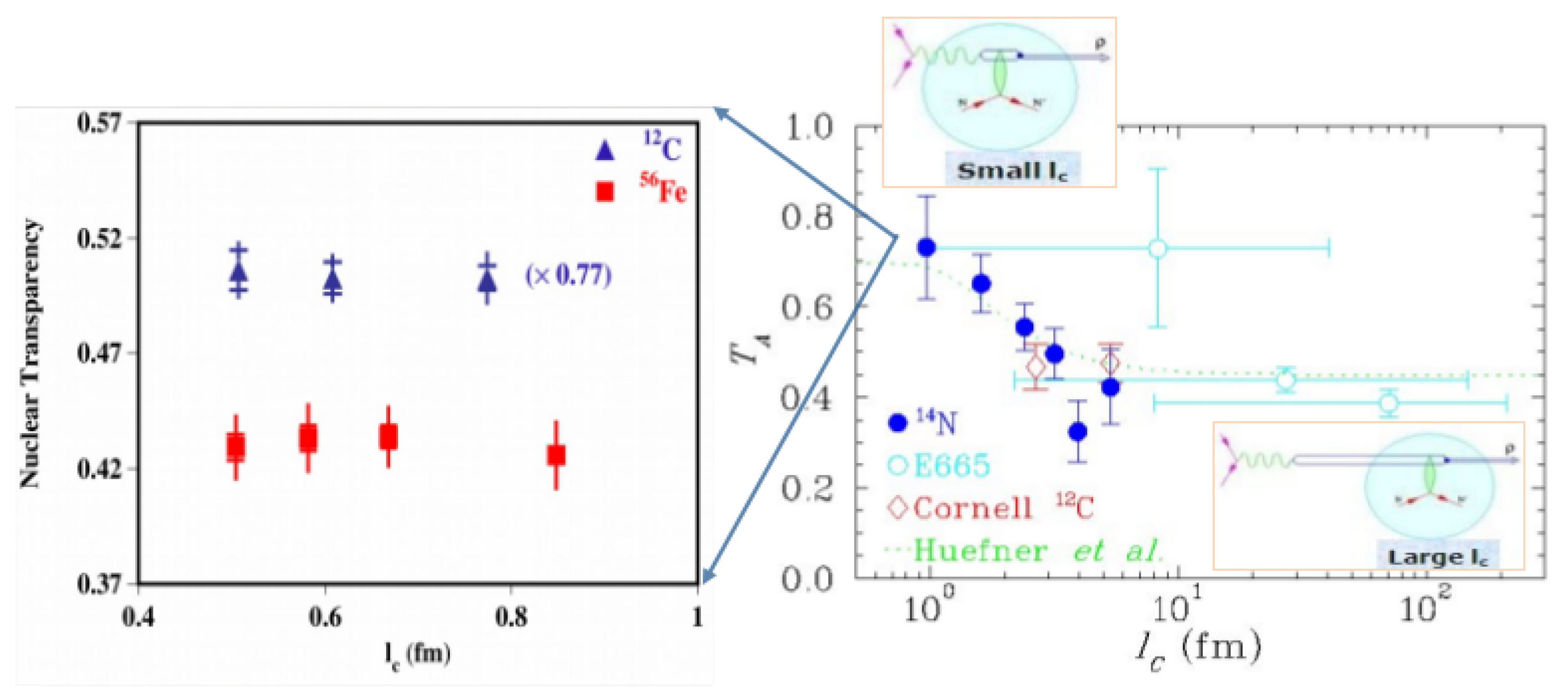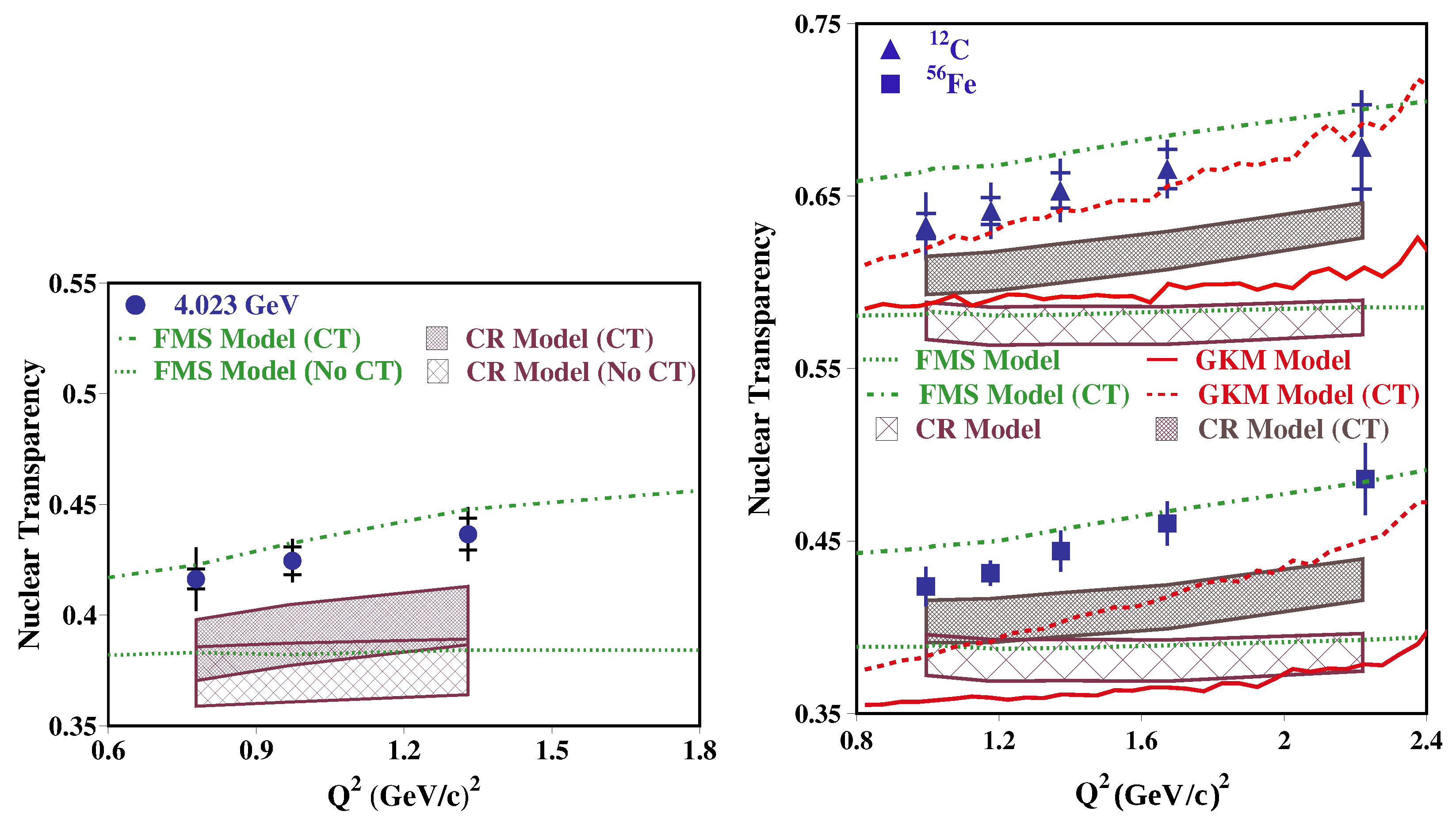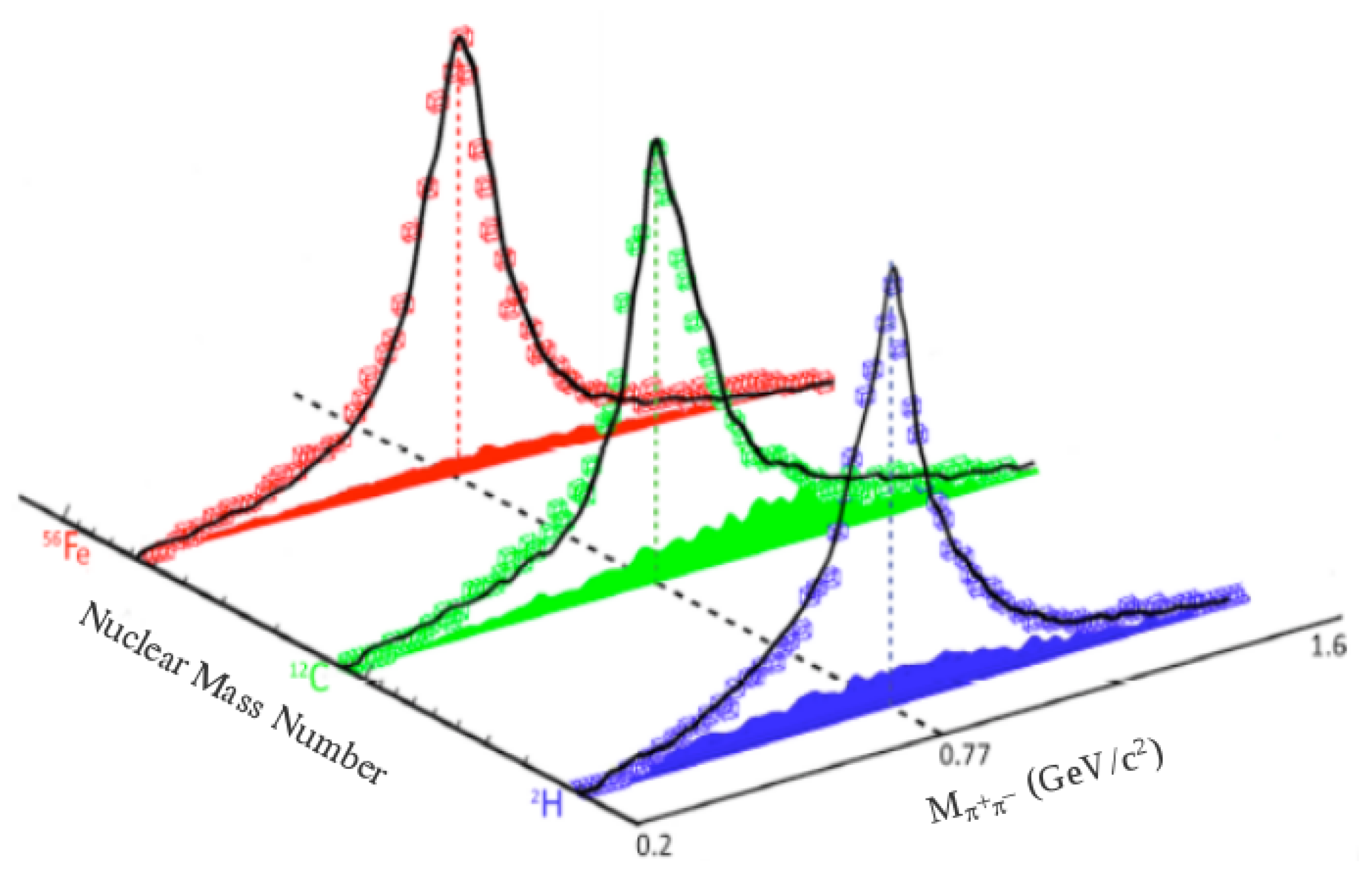Chasing QCD Signatures in Nuclei Using Color Coherence Phenomena
Abstract
:1. Introduction
2. Previous Measurements
2.1. Proton Knockout Experiments
2.2. Meson Production Experiments
2.2.1. Pion Production at JLab
2.2.2. Meson Leptoproduction
3. Forthcoming CLAS12 CT Experiment
4. Conclusions
Funding
Data Availability Statement
Acknowledgments
Conflicts of Interest
References
- Brodsky, S.J.; Mueller, A.H. Using Nuclei to Probe Hadronization in QCD. Phys. Lett. B 1988, 206, 685–690. [Google Scholar] [CrossRef]
- Dutta, D.; Hafidi, K.; Strikman, M. Color transparency: Past, present and future. Prog. Part. Nucl. Phys. 2013, 69, 1–27. [Google Scholar] [CrossRef]
- Frankfurt, L.L.; Miller, G.A.; Strikman, M. Quantum color transparency and nuclear filtering. Ann. Rev. Nucl. Part. Sci. 1994, 44, 501–560. [Google Scholar] [CrossRef]
- Jain, P.; Pire, B.; Ralston, J.P. Quantum color transparency and nuclear filtering. Phys. Rep. 1996, 271, 67–179. [Google Scholar] [CrossRef]
- Perkins, D.H. Ionization at the origin of electron Pairs, and the lifetime of the neutral pion. Phil. Mag. 1955, 46, 1146–1148. [Google Scholar] [CrossRef]
- Dutta, D.; Hafidi, K. The search for the onset of color transparency: A status report. Int. J. Mod. Phys. E 2012, 21, 1230004. [Google Scholar] [CrossRef]
- Blaettel, B.; Baym, G.; Frankfurt, L.L.; Strikman, M. How transparent are hadrons to pions? Phys. Rev. Lett. 1993, 70, 896–899. [Google Scholar] [CrossRef]
- Strikman, M. QCD factorization theorems for DIS exclusive processes and inclusive diffraction: New probes of hadrons and nuclei. Nucl. Phys. A 2000, 663, 64–73. [Google Scholar] [CrossRef]
- Collins, J.C.; Frankfurt, L.L.; Strikman, M. Factorization for hard exclusive electroproduction of mesons in QCD. Phys. Rev. D 1997, 56, 2982–3006. [Google Scholar] [CrossRef]
- Brodsky, S.J.; Frankfurt, L.L.; Gunion, J.F.; Mueller, A.H.; Strikman, M. Diffractive leptoproduction of vector mesons in QCD. Phys. Rev. D 1994, 50, 3134–3144. [Google Scholar] [CrossRef] [Green Version]
- Brodsky, S.J.; Sickles, A. The baryon anomaly: Evidence for color transparency and direct hadron production at RHIC. Phys. Lett. B 2008, 668, 111–115. [Google Scholar] [CrossRef]
- Adler, S.S.; Afanasiev, S.; Aidala, C.; Ajitanand, N.N.; Akiba, Y.; Alexander, J.; Amirikas, R.; Aphecetche, L.; Aronson, S.H.; [PHENIX Collaboration]; et al. Scaling properties of proton and antiproton production in = 200 GeV Au + Au collisions. Phys. Rev. Lett. 2003, 91, 172301. [Google Scholar] [PubMed]
- Carroll, A.S.; Barton, D.S.; Bunce, G.; Gushue, S.; Makdisi, Y.I.; Heppelmann, S.; Courant, H.; Fang, G.; Heller, K.J.; Marshak, M.L.; et al. Nuclear transparency to large-angle pp elastic scattering. Phys. Rev. Lett. 1988, 61, 1698–1701. [Google Scholar] [CrossRef] [PubMed]
- Aclander, J.; Alster, J.; Asryan, G.; Averiche, Y.; Barton, D.S.; Baturin, V.; Buktoyarova, N.; Bunce, G.; Carroll, A.S.; Christensen, N.; et al. Nuclear transparency in quasielastic A(p, 2p) reactions. Phys. Rev. C 2004, 70, 015208. [Google Scholar] [CrossRef]
- Mardor, I.; Durrant, S.; Aclander, J.; Alster, J.; Barton, D.; Bunce, G.; Carroll, A.; Christensen, N.; Courant, H.; Gushue, S.; et al. Nuclear transparency in large momentum transfer quasielastic scattering. Phys. Rev. Lett. 1998, 81, 5085–5088. [Google Scholar] [CrossRef]
- Leksanov, A.; Alster, J.; Asryan, G.; Averichev, Y.; Barton, D.; Baturin, V.; Bukhtoyarova, N.; Carroll, A.; Heppelmann, S.; Kawabata, T.; et al. Energy dependence of nuclear transparency in C(p, 2p) scattering. Phys. Rev. Lett. 2001, 87, 212301. [Google Scholar] [CrossRef]
- Ralston, J.P.; Pire, B. Fluctuating proton size and oscillating nuclear transparency. Phys. Rev. Lett. 1988, 61, 1823–1826. [Google Scholar] [CrossRef]
- Ralston, J.P.; Pire, B. Quantum chromotransparency. Phys. Rev. Lett. 1990, 65, 2343–2346. [Google Scholar] [CrossRef]
- Brodsky, S.J.; de Teramond, G.F. Spin correlations, QCD color transparency and heavy quark thresholds in proton proton scattering. Phys. Rev. Lett. 1988, 60, 1924–1927. [Google Scholar] [CrossRef]
- Garino, G.; Saber, M.; Segel, R.E.; Geesaman, D.F.; Gilman, R.; Green, M.C.; Holt, R.J.; Schiffer, J.P.; Zeidman, B.; Beise, E.J.; et al. Proton propagation in nuclei studied in the (e,e′p) reaction. Phys. Rev. C 1992, 45, 780–790. [Google Scholar] [CrossRef]
- Makins, N.C.R.; Ent, R.; Chapman, M.S.; Hansen, J.; Lee, K.; Milner, R.G.; Nelson, J.; Arnold, R.G.; Bosted, P.E.; Keppel, C.E.; et al. Momentum transfer dependence of nuclear transparency from the quasielastic 12C(e,e′p) reaction. Phys. Rev. Lett. 1994, 72, 1986–1989. [Google Scholar] [CrossRef] [PubMed]
- O’Neill, T.G.; Lorenzon, W.; Arrington, J. A-dependence of nuclear transparency in quasielastic A(e,e′p) at high Q2. Phys. Lett. B 1994, 351, 87–92. [Google Scholar] [CrossRef]
- Abbott, D.; Ahmidouch, A.; Amatuni, T.A.; Armstrong, C.; Arrington, J.; Assamagan, J.A.; Bailey, K.; Baker, O.K.; Barrow, S.; Beard, K.; et al. Quasifree (e,e′p) ureactions and proton propagation in nuclei. Phys. Rev. Lett. 1998, 80, 5072–5076. [Google Scholar] [CrossRef]
- Garrow, K. Nuclear transparency from quasielastic A(e,e′p) reactions up to Q2 = 8.1 (GeV/c)2. Phys. Rev. C 2002, 66, 044613. [Google Scholar] [CrossRef]
- Pandharipande, V.R.; Pieper, C.S. Nuclear transparency to intermediate-energy nucleons from (e,e′p) reactions. Phys. Rev. C 1992, 45, 791–798. [Google Scholar] [CrossRef]
- Bhetuwal, D.; Matter, J.; Szumila-Vance, H.; Kabir, M.L.; Dutta, D.; Ent, R.; Abrams, D.; Ahmed, Z.; Aljawrneh, B.; Alsalmi, S.; et al. Ruling out color transparency in quasielastic 12C(e,e′p) up to Q2 of 14.2 (GeV/c)2. Phys. Rev. Lett. 2021, 126, 082301. [Google Scholar] [CrossRef]
- Frankfurt, L.L.; Moniz, E.J.; Sargsian, M.M.; Strikman, M. Correlation effects in nuclear transparency. Phys. Rev. C 1995, 51, 3435–3444. [Google Scholar] [CrossRef]
- Cosyn, W.; Martinez, M.C.; Ryckebusch, J.; Van Overmeire, B. Nuclear transparencies from photoinduced pion production. Phys. Rev. C 2006, 74, 062201. [Google Scholar] [CrossRef]
- Aitala, E.M.; Amato, S.; Anjos, J.C.; Appel, J.A.; Ashery, D.; Banerjee, S.; Bediaga, I.; Blaylock, G.; Bracker, S.B.; Burchat, P.R.; et al. [Fermilab E791 Collaboration] Observation of color–transparency in diffractive dissociation of pions. Phys. Rev. Lett. 2001, 86, 4773–4777. [Google Scholar] [CrossRef]
- Dutta, D.; Xiong, F.; Zhu, L.Y.; Arrington, J.; Averett, T.; Beise, E.; Calarco, J.; Chang, T.; Chen, J.P.; Chudakov, E.; et al. [Jefferson Lab E94104 Collaboration] Nuclear transparency with the γn → π−p process in 4He. Phys. Rev. C 2003, 68, 021001. [Google Scholar] [CrossRef] [Green Version]
- Gao, H.; Holt, R.J.; Pandharipande, V.R. γn → pi−p process in 4He and 16O. Phys. Rev. C 1996, 54, 2779–2782. [Google Scholar] [CrossRef]
- Dugger, M.; Ritchie, B.G.; Sparks, N.; Anassontzis, E.G.; Kourkoumeli, C.; Vasileiadis, G.; Jarvis, N.S.; Levine, W.I.; McCracken, M.; McGinley, W.; et al. Probing QCD in the Nuclear Medium with Real Photons and Nuclear Targets at GlueX; Proposal PR12-17-007; Thomas Jefferson National Accelerator Facility: Newport News, VA, USA, 2017; Available online: https://www.jlab.org/exp_prog/proposals/17/PR12-17-007.pdf (accessed on 10 August 2022).
- Clasie, B.; Qian, X.; Arrington, J.; Asaturyan, R.; Benmokhtar, F.; Boeglin, W.; Bosted, P.; Bruell, A.; Christy, M.E.; Chudakov, E.; et al. Measurement of nuclear transparency for the A(e, e′π+) reaction. Phys. Rev. Lett. 2007, 99, 242502. [Google Scholar] [CrossRef]
- Larson, A.; Miller, G.A.; Strikman, M. Pionic color transparency. Phys. Rev. C 2006, 74, 01820. [Google Scholar] [CrossRef]
- Dutta, D.; Ent, R. Update on E12-06-107: Hadron Propagation and ColorTransparency at 12 GeV; Run Group Proposal E12-06-107; Thomas Jefferson National Accelerator Facility: Newport News, VA, USA, 2019; Available online: https://www.jlab.org/exp_prog/proposals/19/E12-06-107%20Update.pdf (accessed on 10 August 2022).
- Bauer, T.H.; Spital, R.D.; Yennie, D.R.; Pipkin, F.M. The hadronic properties of the photon in high-energy interactions. Rev. Mod. Phys. 1978, 50, 261–436. [Google Scholar] [CrossRef]
- Piller, G.; Weise, W. Nuclear deep inelastic lepton scattering and coherence phenomena. Phys. Rep. 2000, 330, 1–94. [Google Scholar] [CrossRef]
- Ackerstaff, K.; Airapetian, A.; Akopov, N.; Akushevich, I.; Amarian, M.; Aschenauer, E.C.; Avakian, H.; Avakian, R.; Avetissian, A.; [HERMES Collaboration]; et al. Observation of a coherence length effect in exclusive ρ0 electroproduction. Phys. Rev. Lett. 1999, 82, 3025–3029. [Google Scholar] [CrossRef]
- Kopeliovich, B.Z.; Nemchik, J.; Schafer, A.; Tarasov, A.V. Color transparency versus quantum coherence in electroproduction of vector mesons off nuclei. Phys. Rev. C 2002, 65, 035201. [Google Scholar] [CrossRef]
- El Fassi, L.; Zana, L.; Hafidi, K.; Holtrop, M.; Mustapha, B.; Brooks, W.; Hakobyan, H.; Zheng, X.; Adhikari, K.; Adikaram, D.; et al. [CLAS Collaboration] Evidence for the onset of color transparency in ρ0 electroproduction off nuclei. Phys. Lett. B 2012, 712, 326–330. [Google Scholar] [CrossRef]
- Hufner, J.; Kopeliovich, B.; Nemchik, J. Glauber multiple scattering theory for the photoproduction of vector mesons off nuclei and the role of the coherence length. Phys. Lett. B 1996, 383, 362–366. [Google Scholar] [CrossRef]
- Adams, M.R.; Aïd, S.; Anthony, P.L.; Averill, D.A.; Baker, M.D.; Baller, B.R.; Banerjee, A.; Bhatti, A.A.; Bratzler, U.; [Fermilab E665 Collaboration]; et al. Measurement of nuclear transparencies from exclusive ρ0 meson production in muon-nucleus scattering at 470 GeV. Phys. Rev. Lett. 1995, 74, 1525–1529. [Google Scholar] [CrossRef]
- Airapetian, A.; Akopov, N.; Akopov, Z.; Amarian, M.; Ammosov, V.V.; Andrus, A.; Aschenauer, E.C.; Augustyniak, W.; Avakian, R.; [HERMES Collaboration]; et al. Q2 dependence of nuclear transparency for exclusive ρ0 production. Phys. Rev. Lett. 2003, 90, 052501. [Google Scholar] [CrossRef] [PubMed]
- Mecking, B.A.; Adams, G.; Ahmad, S.; Anciant, E.; Anghinolfi, M.; Asavapibhop, B.; Asryan, G.; Audit, G.; Auger, T.; Avakian, H.; et al. The CEBAF Large Acceptance Spectrometer (CLAS). Nucl. Instrum. Meth. A 2003, 503, 513–553. [Google Scholar] [CrossRef]
- El Fassi, L.; Hafidi, K.; Mustapha, B.; Holtrop, M.; Zana, L.; Brooks, W.; Hakobyan, H. Search for the Onset of Color Transparency via ρ0 Electroproduction off Nuclei; Report CLAS-NOTE 2012-001; Thomas Jefferson National Accelerator Facility: Newport News, VA, USA, 2012; Available online: https://misportal.jlab.org/ul/Physics/Hall-B/clas/viewFile.cfm/2012-001.pdf?documentId=669 (accessed on 10 August 2022).
- Frankfurt, L.; Miller, G.A.; Strikman, M. Color transparency in semi-inclusive electroproduction of rho mesons. Phys. Rev. C 2008, 78, 015208. [Google Scholar] [CrossRef]
- Gallmeister, K.; Kaskulov, M.; Mosel, U. Color transparency in hadronic attenuation of ρ0 mesons. Phys. Rev. C 2011, 83, 015201. [Google Scholar] [CrossRef]
- Cosyn, W.; Ryckebusch, J. Nuclear ρ meson transparency in a relativistic Glauber model. Phys. Rev. C 2013, 87, 064608. [Google Scholar] [CrossRef]
- Kopeliovich, B.Z.; Nemchik, J.; Schmidt, I. Color transparency at low energies: Predictions for JLab. arXiv 2007, arXiv:hep-ph/0702272. [Google Scholar] [CrossRef]
- Farrar, G.R.; Liu, H.; Frankfurt, L.L.; Strikman, M.I. Transparency in nuclear quasiexclusive processes with large momentum transfer. Phys. Rev. Lett. 1988, 61, 686–689. [Google Scholar] [CrossRef]
- Armstrong, W.; Ayerbe, C.; Brooks, W.; Chetry, T.; Dupré, R.; Dutta, D.; El Alaoui, A.; El Fassi, L.; Joosten, S.; Kim, J.; et al. Jeopardy Update on E12-06-106: RG-D Experiment Study of Color Transparency in Exclusive Vector Meson Electroproduction off Nuclei. JLab Experiment E12-06-106. 2020. Available online: https://www.jlab.org/exp_prog/proposals/20/Jeopardy/Run%20Group%20D_Update.pdf (accessed on 10 August 2022).
- Jefferson Lab CLAS12. Available online: https://www.jlab.org/physics/hall-b/clas12 (accessed on 10 August 2022).
- CLAS12 GEant4 Monte-Carlo (GEMC) Framework. Available online: https://gemc.jlab.org/gemc/html/index.html (accessed on 10 August 2022).
- Cassel, D.G.; Ahrens, L.A.; Berkelman, K.; Day, C.T.; Gibbard, B.G. Exclusive ρ0, ω and ϕ Electroproduction. Phys. Rev. D 1981, 24, 2787. [Google Scholar] [CrossRef]
- Huber, G.M.; Li, W.B.; Cosyn, W.; Pire, B. u-channel color transparency observables. Physics 2022, 4, 451–461. [Google Scholar] [CrossRef]
- Jain, P.; Pire, B.; Ralston, J.P. The status and future of color transparency and nuclear filtering. Physics 2022, 4, 578–589. [Google Scholar] [CrossRef]
- Larionov, A.B.; Strikman, M.; Bleicher, M. Color transparency in π−-induced dilepton production on nuclei. Phys. Rev. C 2016, 93, 034618. [Google Scholar] [CrossRef]
- Gevorkyan, S. Vector mesons polarization versus color transparency. EPJ Web Conf. 2017, 138, 08004. [Google Scholar] [CrossRef]
- Gevorkyan, S. Hadronic properties of the photon. EPJ Web Conf. 2019, 204, 05012. [Google Scholar] [CrossRef]
- Arrebato Villar, D.Y.; Bell, A.; Guzmãn, F. Color transparency in ρ0,ϕ, and J/Ψ mesons photoproduction. Astron. Nachr. 2017, 338, 1118–1122. [Google Scholar] [CrossRef]
- Das, S. Color transparency of K+ mesons in inclusive (e,e′) reactions on nuclei. Phys. Rev. C 2019, 100, 035203. [Google Scholar] [CrossRef]
- Larionov, A.B.; Strikman, M. Color transparency in p¯d → π−π0p reaction. Eur. Phys. J. A 2020, 56, 21. [Google Scholar] [CrossRef]
- Larionov, A.; Strikman, M. Color transparency and hadron formation effects in high-energy reactions on nuclei. Particles 2020, 3, 24–38. [Google Scholar] [CrossRef] [Green Version]






| 5 GeV Dataset Results | |||||
| Nuclei | Measured Slopes (GeV/c) | Model Predictions | |||
| CR | FMS | GKM | KNS | ||
| C | 0.029 | 0.06 | 0.06 | ||
| Fe | 0.032 | 0.047 | 0.047 | ||
| 4 GeV Dataset Results | |||||
| Fe | 0.033 | - | - | ||
Publisher’s Note: MDPI stays neutral with regard to jurisdictional claims in published maps and institutional affiliations. |
© 2022 by the author. Licensee MDPI, Basel, Switzerland. This article is an open access article distributed under the terms and conditions of the Creative Commons Attribution (CC BY) license (https://creativecommons.org/licenses/by/4.0/).
Share and Cite
El Fassi, L. Chasing QCD Signatures in Nuclei Using Color Coherence Phenomena. Physics 2022, 4, 970-980. https://doi.org/10.3390/physics4030064
El Fassi L. Chasing QCD Signatures in Nuclei Using Color Coherence Phenomena. Physics. 2022; 4(3):970-980. https://doi.org/10.3390/physics4030064
Chicago/Turabian StyleEl Fassi, Lamiaa. 2022. "Chasing QCD Signatures in Nuclei Using Color Coherence Phenomena" Physics 4, no. 3: 970-980. https://doi.org/10.3390/physics4030064
APA StyleEl Fassi, L. (2022). Chasing QCD Signatures in Nuclei Using Color Coherence Phenomena. Physics, 4(3), 970-980. https://doi.org/10.3390/physics4030064





